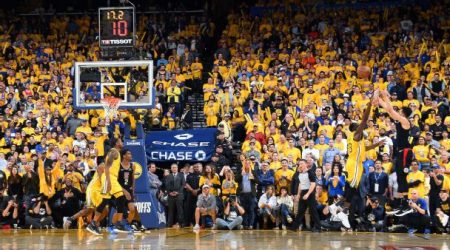5:03 am | May 22, 2019 | Go to Source | Author:
-
Kevin Pelton
Close
ESPN Staff Writer
- Co-author, Pro Basketball Prospectus series
- Formerly a consultant with the Indiana Pacers
- Developed WARP rating and SCHOENE system
-
Baxter Holmes
Close
ESPN Senior Writer
- Baxter Holmes (@Baxter) is a senior writer for ESPN Digital and Print, focusing on the NBA. He has covered the Lakers, the Celtics and previously worked for The Boston Globe and Los Angeles Times.
WITH 24 MINUTES in the books the LA Clippers are stuck in a steep hole, staring up at a 23-halftime deficit on the road to the two-time defending champion Golden State Warriors. Clippers coach Doc Rivers addresses his players in the locker room at Oracle Arena, telling them that, somehow, they’re going to figure it out — that, somehow, they’re going to win this game.
“Just hang in there long enough,” Rivers says.
But their hole becomes even steeper in the second half of Game 2 of this first-round playoff series: Soon, they’re down 31 points with 7:31 left in the third quarter. Then, JaMychal Green trails a driving Lou Williams and throws down a slam. Green finds a cutting Williams on the next possession for a quick 2. And on the very next play Williams pushes the ball to Green for a corner 3. The 31-point lead is down to 24 in less than a minute and shrinks to 14 by the end of the third quarter.
Oracle Arena is silent as the Clippers continue their frenetic march — an 11-point deficit becomes eight on a Danilo Gallinari 3 with just over six minutes left; the eight-point deficit becomes four on a Williams floater. All the way down the lead dwindles until rookie guard Landry Shamet nails a clutch 3-pointer late in the game to seal what becomes the greatest comeback in NBA playoff history.
For the Clippers, such a turnaround isn’t a surprise — the rally in Oakland was their third win like this of the year. Before this season, no team had more than one 25-point-comeback win in a season since play-by-play data became available in 1996-97.
It’s not just the Clippers, though. Comebacks are on the come-up all across the league — and dramatically so. In fact, there were 28 different comebacks from a 20-point or larger deficit during the 2018-19 season, up from 26 the previous year.
Before that, in the 23 seasons for which NBA Advanced Stats tracked in-game margins, there were never more than 19 such comebacks in any season.
So what happened?
ONE PLAUSIBLE EXPLANATION? The explosion of huge in-game leads.
Consider: There were 491 games this season in which a team had a 20-point lead.
Previously, the most was 473 in 2016-17, and as recently as 2010-11 there were just 369 games featuring a lead of 20-plus points.
Nonetheless, even when we look at the winning percentage of teams with 20-point leads, the last two seasons stand out as featuring comebacks most frequently. Though it fluctuated from year to year, the average winning percentage for teams with 20-point leads at any time during a game from 1996-97 through 2016-17 was 97.2 percent. Over the last two seasons, that’s dropped to 94.6 percent, meaning such comebacks have been nearly twice as common.
The two trendlines — more 20-point leads, and more comebacks — suggest a common cause: bigger swings within games, attributable both to increasing pace of play and the rising share of shots from beyond the 3-point line. Teams are building larger leads earlier (there were 44 games this season in which a team went up by at least 20 in the first quarter, as compared to 28 in 2015-16), but finding them more difficult to protect.
“It doesn’t surprise me because I think the 3-point line has helped,” Rivers says of the rise in comebacks. “For sure. In the old days, that would surprise me.”
“Because of the proliferation of 3 shots, it’s a great equalizer and certainly allows you to come back in games quicker than before,” says Portland Trail Blazers coach Terry Stotts.
A polling of general managers, front-office executives and coaches across the league reflects the same sentiment.
“It’s just exceptionally hard to preserve leads when the potency of offense these days is just so much greater,” one veteran assistant coach says. “With the way it’s trended, it puts so much pressure on the other team who finds themselves playing not to lose instead of playing to win.”
HOW DOES A comeback happen?
If you’re looking for signs that a lead is vulnerable, they’re fairly common-sense. On average, teams that lose 20-point leads tend to be worse than those that come back. Weighted by the number of times they were involved, the teams on the wrong end of 20-point comebacks averaged 39 wins during the regular season to 43 for the teams that come back and win. So naturally, unexpected leads are more tenuous than predictable ones.
Three times this season, the lead reached 20 or more in the first quarter before the opposition eventually came back. Most frequently (16 times), the lead peaked in the second quarter. And nine times, teams came back from 20-point deficits in the second half.
Additionally, teams that amass 20-point leads tend to be unusually hot from 3-point range, making 55.3 percent of their shots from downtown up the point where their advantage peaks, while the team that falls behind shoots just 28.5 percent on 3s. And then, over the course of the comeback, that advantage flips. During the comeback, trailing teams shoot 45.7 percent from beyond the arc to a dismal 22.2 percent for the teams that lose their lead — more than doubling them up from long distance.
What’s perhaps more interesting is what doesn’t happen during the comebacks. The style of play doesn’t change much, even if some coaches and executives believe — anecdotally — that it becomes a factor.
Pace of play is virtually the same before and after the biggest lead of the game, and trailing teams don’t really go wild in terms of shooting 3s. (The percentage of their attempts from 3 does go up from 38.4 percent before the biggest lead to 41.2 percent during the comeback, but so too do 3-point attempts for teams with the lead, from 35.6 percent to 37.5 percent, so this might be a product of teams shooting more 3s as they fatigue over the course of a game.)
That strategic standoff may reflect both coaches emphasizing opposite objectives to their teams.
“[With a lead] I find myself and my coaching staff all throughout the fourth quarter saying, ‘Don’t give up 3s. Don’t give up 3s. Don’t give up 3s.’ I think that’s the biggest mentality,” Stotts said. “On the flip side of it, if you’re the team coming from behind, you’re basically saying, ‘If you’re open, let it fly. We’ve got to make up some ground.'”
The conventional wisdom that teams that shoot more 3s are vulnerable to comebacks doesn’t bear out statistically. The 10 teams with the highest rates of 3-point attempts this season collectively won 96.4 percent of games they led by 20-plus, as compared to 91.7 percent for the bottom 10 teams in 3-point attempts and 94.4 percent for the other 10 teams.
Though teams that attempt a lot of 3s were more likely to come back (they won 9.9 percent of games they trailed by 20-plus, as compared to 3.0 percent for teams in the bottom 10), could be explained by the fact that teams that attempt more 3s are generally more successful. The top 10 teams in 3-point attempt rate averaged 47 wins, as compared to 33 wins for the bottom 10 teams in 3s attempted.
ON THE LAST night of the NBA regular season, the Western Conference playoff picture — and ultimately the path to the NBA Finals — is in the hands of the Blazers’ reserves.
A win against the lottery-bound Sacramento Kings, along with one by the Denver Nuggets over the Minnesota Timberwolves, would give the Blazers the third seed in the West and push the Rockets down to fourth and a potential semifinals matchup with the Warriors.
Yet Portland, wary of overtaxing its key players in the second game of a back-to-back and perhaps not wanting to face the Oklahoma City Thunder in the first round after getting swept in the regular-season series, has rested all five starters and three top reserves. Just six players, four of them in their first or second season, take the court against Sacramento.
Nearing halftime, the Kings take a 28-point lead. Throughout the West, travel plans and scouting reports start being made under the assumption the Blazers will finish fourth.
But then, as quickly as Sacramento had built the lead, it vanishes. Portland’s makeshift squad, three players from which (Jake Layman, Anfernee Simons and Gary Trent) play all 48 minutes, make up the deficit, setting up a first-round series against Oklahoma City that the Blazers would win behind more predictable heroics from All-Star Damian Lillard.
“That comeback changed the dynamics of the playoffs for a lot of teams, but certainly for us,” Stotts said during the second round en route to a Western Conference finals loss to Golden State. “You’d like to think that we still would have won the first series and we would have been competitive in the second series, but it certainly did change the dynamics of the playoffs.”
As important as the Portland’s 28-point comeback was, Stotts doesn’t buy that it’s emblematic of the larger trend.
“The problem with the Sacramento game is it was both teams’ third team out there, so I don’t know if I could lump that in with NBA regular-season games,” he said. “It was at home, there was a lot of momentum, you had a lot of young guys running around out there playing hard.”
If Portland’s comeback was atypical because of the reserves involved, so too was the Clippers’ rally from a 31-point deficit because of the setting, the opponent and the playoff stakes. Rivers preached belief in the locker room, but it goes beyond that.
“You have to believe that you can [come back],” he said later. “But then you need something that will happen on the floor that allows them to believe. Belief ain’t good enough.”
What a team needs next, according to Rivers, are manageable goals — such as shrinking a deficit to 18 points, then 14, then 12.
“Then once you get it to 12, you don’t have to talk about goals anymore,” Rivers said. “Now they’re going [to think], ‘We’re going to win this.'”
Powered by WPeMatico


